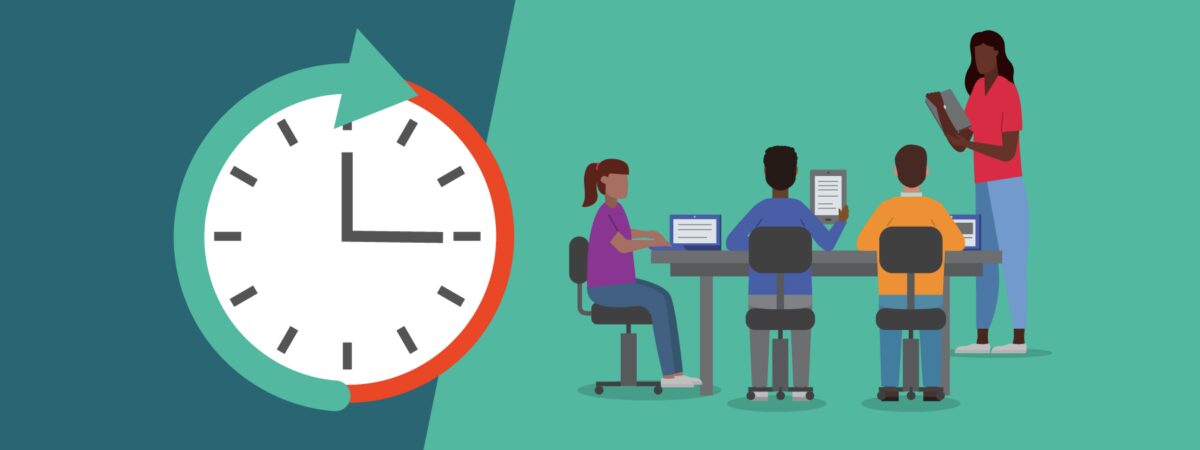
All too often, this core question is overlooked due to busy schedules, a lack of clarity about the tool’s purpose, how it fits into day-to-day use, and the recommended practices. Deep partnerships between districts and providers committed to shared accountability through Outcomes Based Contracting (OBC) have revealed critical gaps in understanding whether a product is implemented with fidelity—or even in defining what fidelity means. This challenge is largely driven by limited and unclear implementation guidance from edtech providers and how these recommendations translate into real-life classrooms.
“Recommended dosage” typically describes how often and for how long learners need to use a tool to realize its intended benefits. All edtech providers should clearly articulate a “recommended dosage” for their tool. Ideally, districts use the tool enough to meet the recommended dosage, often referred to as “implementation with fidelity.” Recommended practices call for edtech providers to utilize efficacy research to define the appropriate dosage for their tools. However, there is no standard definition of “dosage,” and how edtech providers define recommended dosage varies widely across tools.
We reviewed dosage recommendations across some of the most used edtech tools within the United States K-12 market to provide examples:
In many cases, a tool’s recommended dosage is not listed on its website. However, districts and schools should ask about dosage when considering using the edtech tool to understand: 1) whether the tool’s efficacy is supported by research, and if so, 2) whether the research-suggested dosage is feasible for their context.
Even if dosage requirements were clear from the providers, districts often don’t have the right data they need to understand their own edtech usage. In fact, less than one third of districts report any data collected on frequency or effectiveness of their edtech tool use. Research that has looked at implementation fidelity specifically has found that less than five percent of students are using the tools “as recommended.” To address a myriad of market challenges, including implementation, the OBC model is designed to require mutual accountability between the districts and the edtech providers.In these contracts, the providers name upfront the expected dosage requirements and offer data reporting to enable districts to track progress and meet the required dosage expectations.
The challenge with recommended dosage that has surfaced through OBC implementation is that it doesn’t always fit well within the reality of classrooms. Often, implementation practices do not include accountability requirements, which means districts and products lack clarity on usage expectations or a plan to track usage. The traditional approach to purchasing tools without collaborating with school leaders, coaches, and educators to develop an implementation plan often prevents districts from identifying this misalignment. The accountability requirements in the OBC model have enabled districts to focus on how much they should use the tool by clearly identifying the recommended dosage, and ensuring the right district leaders, school leaders, coaches, and educators have the data they need to understand and monitor usage in real time. This approach has created “superusers,” or users who are actually implementing the tool as closely to recommended dosage as they can.
Furthermore, the disconnect between recommended dosage and implementation is not typically seen as a market issue. Most providers have only a handful of superusers who have identified the dosage issue. Because so few users have reported the issue, most providers have not dedicated the necessary resources to understand or clarify dosage. Providers usually develop their definition of dosage through randomized controlled trials or similar research, which may not account for the myriad users and contexts in which the tool will be used. In practice, dosage recommendations may need to be adjusted to reflect real-world implementation.
In these cases, the ideal scenario is for the provider and district to collaborate on research-informed adjustments to the implementation plan, ensuring developmentally appropriate use of the edtech tool for the given context. OBC superusers highlight an under-researched area worthy of deeper exploration and a seemingly “quick win” opportunity for immediate impact in the field.
During contract negotiations, district leaders and providers should:
Throughout implementation, district leaders and providers should:
By strengthening their partnership, districts and providers can better identify and remove barriers to implementation, ensuring learners have the best opportunity to gain the greatest benefits from the products at no additional cost.
Learn more about ways to evaluate the tools you consider through Product Certifications, including through Requests for Proposals and internal review of existing tools. Sign up for our newsletter and follow Digital Promise on LinkedIn, Instagram, and Facebook to stay updated on edtech and emerging technologies.